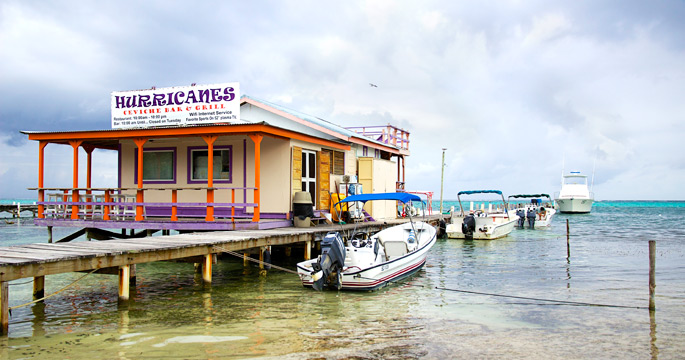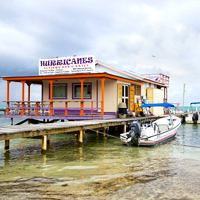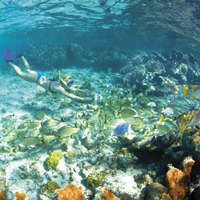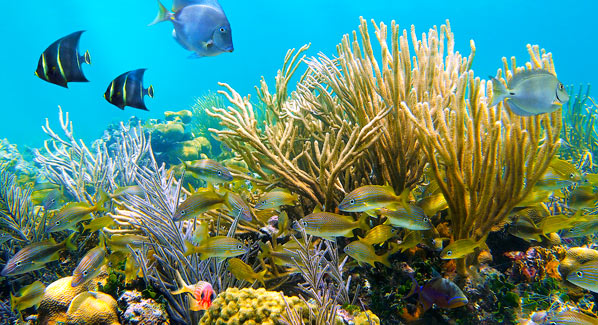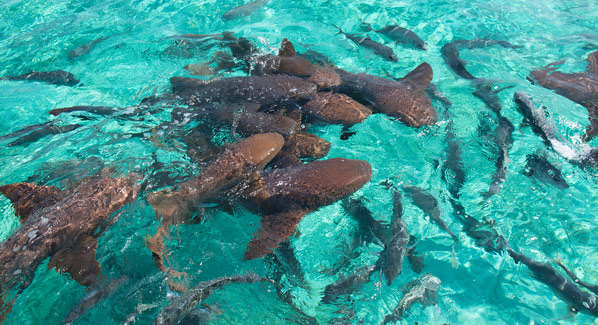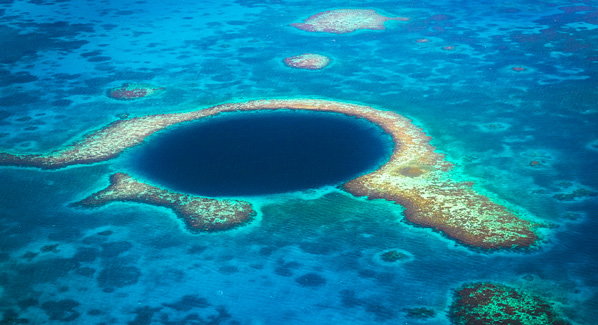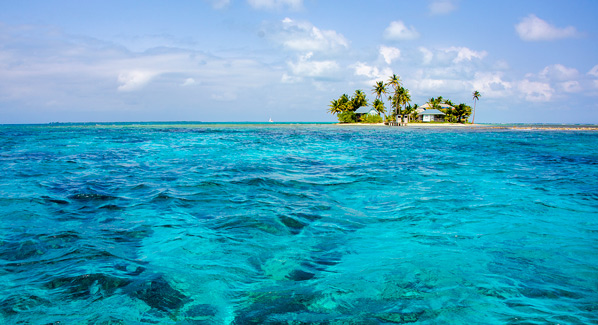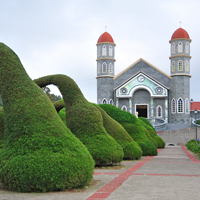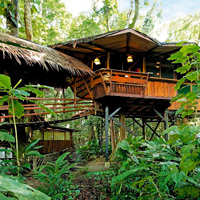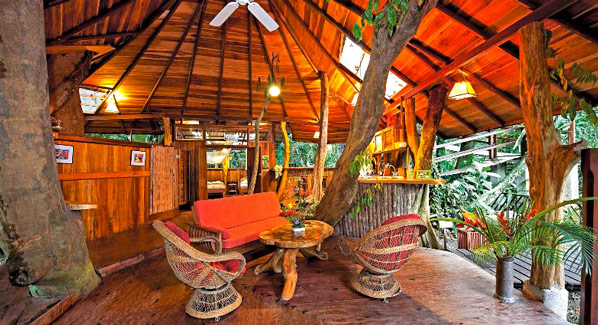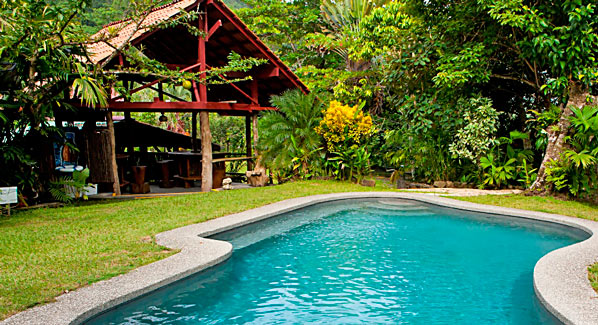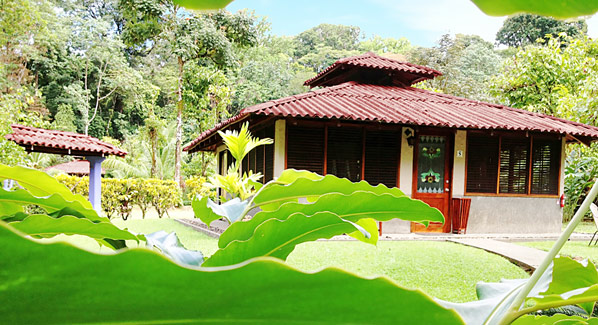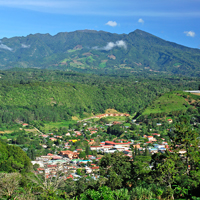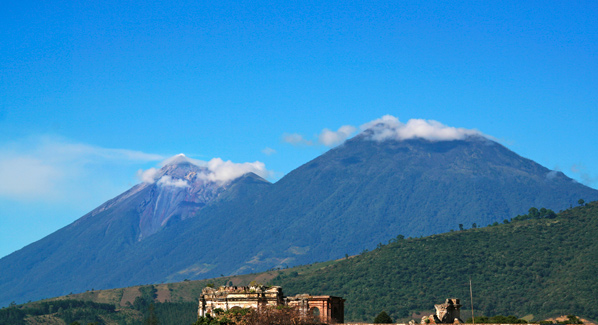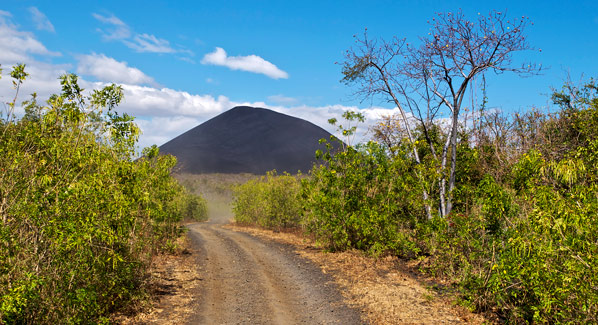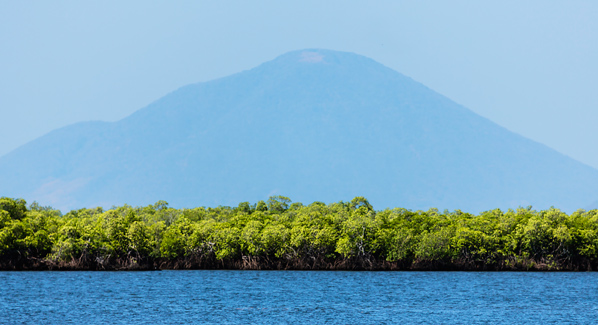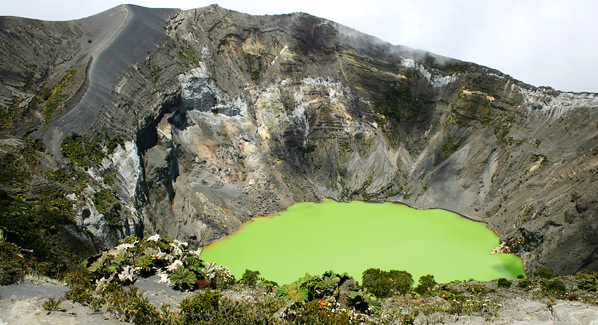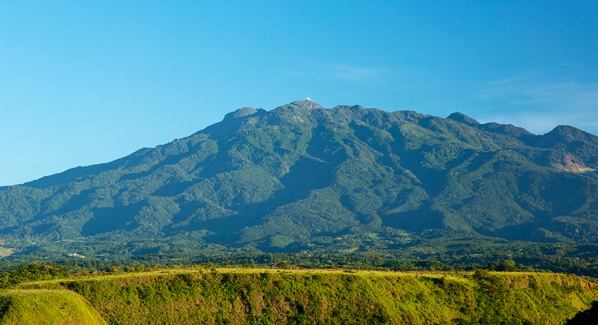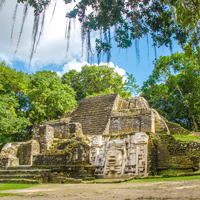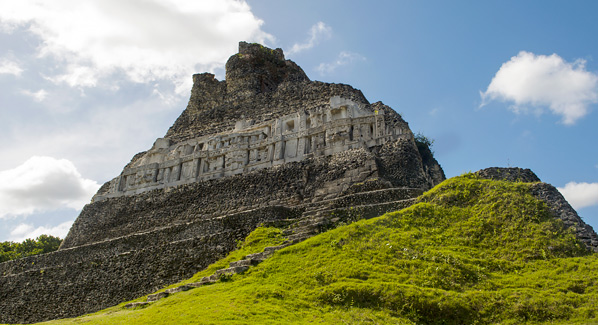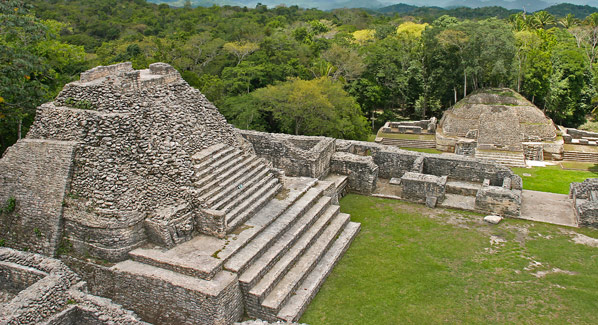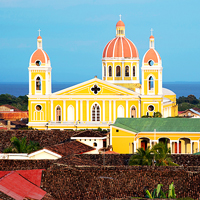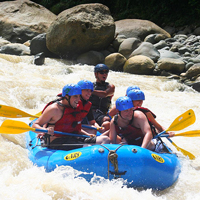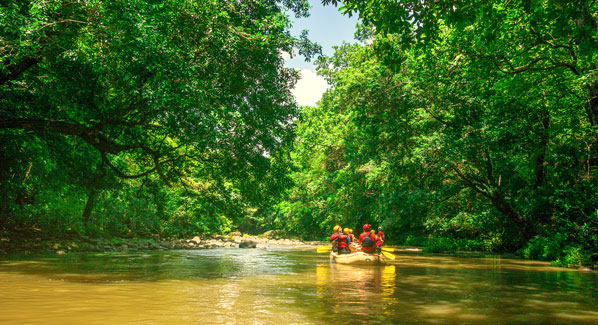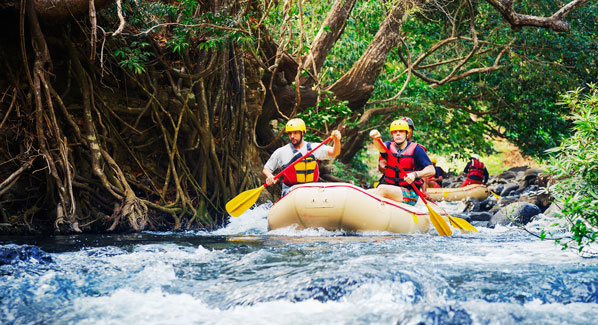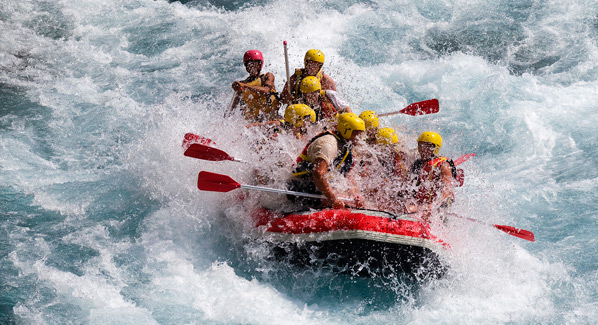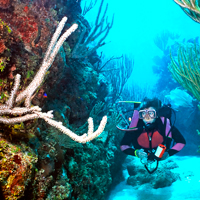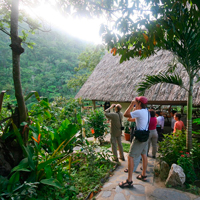Sun and sand draw vacationers to the shores of Belize, but an ever-growing number of travelers are also looking inland. Here, verdant rainforests are cut by jungle streams, and mountain ranges are perforated by caves and underground rivers. The lost cities of the once-mighty Mayan empire lie waiting to be discovered, and the forests are alive with exotic animals such as peccaries, jaguars and monkeys, along with more than 300 species of birds.
Scattered through this lush landscape is a collection of small resorts. Unlike the glass-and-concrete monoliths of urban and beachfront settings, these are simpler abodes fabricated from native materials and constructed in traditional styles of the region. They are Belize’s jungle lodges, places where one can wake to bird calls, dine on locally grown foods under a thatched palapa, and discover medicinal plants, birds and butterflies along wooded paths. Many of these same lodges also offer a reasonable dose of civilization, with on-site spas, eco-friendly swimming pools and—for those who just have to stay connected—WiFi service. Destinations in their own right, they also serve as base camps for a wide range of jungle adventures, everything from horseback rides and tours of archeological sites to zip-line flights and inner tube floats through river caves. Much of this activity centers around the Cayo district and the town of San Ignacio. Several first-class jungle lodges are located within this region. Here are four of our favorites.
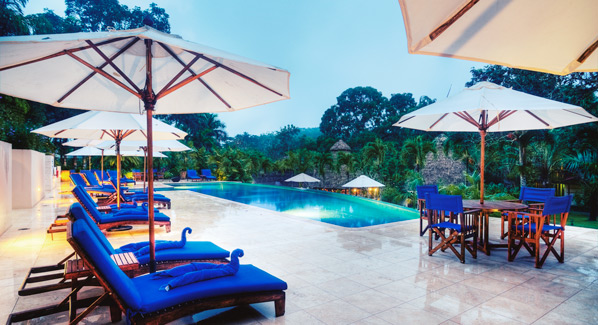
The Lodge at Chaa Creek blends select luxuries such as a freshwater pool and available WiFi with opportunities for off-grid stays at a more secluded jungle camp. Photo: Chaa Creek Lodge
The Lodge at Chaa Creek
Belize’s original jungle lodge has evolved from a pair of cottages accessible only by river into one of the world’s best known and most highly awarded eco resorts. Today, a collection of 23 bungalows combine the rustic thatched-roof appeal that started it all with creature comforts that range from charmingly basic to downright decadent. At Chaa Creek, guests can bunk down in the rustic comfort of the Macal River Camp, which is unplugged, but far from uncivilized; those who want WiFi coverage along with their time in nature can stay closer to the central compound at one of several electrified suites, complete with a private Jacuzzi tub. All guests can dine on locally sourced meals at the resort’s highly acclaimed dining room, lounge by the eco-friendly pool or book a treatment at the on-site spa.
The owners, Mick and Lucy Fleming, have expanded their original farm plot into a 365-acre rainforest reserve that includes organic gardens, a natural history center, a butterfly farm and a trail system that gives access to Mayan cultural sites and a medicinal plant repository. On-property activities include canoeing on the Macal River, morning bird-watching sessions with a staff naturalist, visits to Mayan farms, and horseback and mountain bike rides. The lodge can also bundle a wide range of off-property adventures into a stay, and 10 percent of all accommodation revenue is set aside for environmental education and community-enhancement projects.
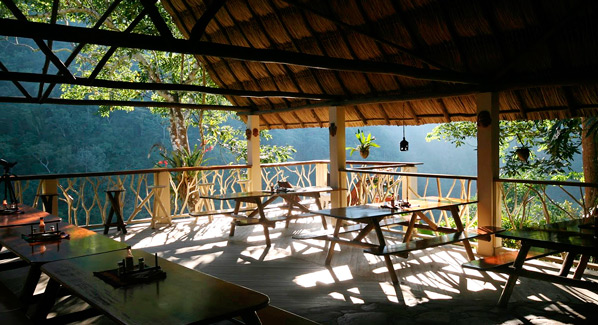
The communal dining area at Black Rock Lodge sits on the edge of a high bluff overlooking its namesake canyon, with the Macal River flowing hundreds of feet below. Photo: Black Rock Lodge
Black Rock Lodge
The most remote of the San Ignacio area jungle resorts, the Black Rock Lodge is a 45-minute drive from town, with the final six miles along an unpaved track. The rewards for this isolation are a commanding view of the Macal River, snaking its way through the Black Rock Canyon below, and proximity to Elijio Panti National Park. The lodge’s 14 hillside cabins are constructed of native wood and slate rock, with vaulted roofs and large screened windows to take advantage of the mountain breezes. Interiors are simply but tastefully furnished and decorated with the work of local artists and craftsmen. Front porch hammocks are a favorite place to take in river views and rest after a day’s adventure.
The most stunning vistas on the property are from the high-roofed dining palapa, which sits on the edge of a slope, above the river. The lodge is energy independent, generating all power from solar and hydroelectric sources, and most of the organic fruits and vegetables served in the restaurant are grown here. From the resort, hiking trails lead to the river and the national park’s adjacent 13,000 acres. By foot, mountain bike or horseback, guests can visit sites such as Vaca Falls or Flour Camp Cave, which is filled with ancient Maya pottery. A second community palapa, half way to the river, is ideal for birding and serves as the site of daily yoga classes. A culmination highlight of each day is the four-course dinner served family style against the waning evening light in the gorge.

The Macal River begins in Belize’s mountainous interior and flows through Black Rock Canyon before emerging into the lowlands. Several jungles lodges line its banks. Photo: Black Rock Lodge
Mystic River Resort
One of Belize’s newest jungle lodges has already earned accolades for guest service, including the Belize Hotel Association’s award for Hotelier of the Year. Located seven miles upstream of San Ignacio on the Macal River, the Mystic River Resort is the dream of Canadian expats Tom and Nadege Thomas, who welcomed their first guests in early 2009. Like other eco- themed lodges along this stretch of the river, this property is committed to sustainable tourism. There is an ongoing program to replant indigenous hardwoods, and the resort generates its own electricity, maintains an organic garden to supply the kitchen and purifies its own water.
Accommodations currently include five studio suites and three single- bedroom bungalows, with two additional suites to be completed by late 2014. Another recent expansion was the opening of the on-site Jasmine Spa in the fall of 2013. This facility is surrounded by lush jungle foliage and water features that add a natural ambience to the spa experience. The resort has a pool, but guests can also enjoy a dip in the cool river waters. Other highlights of a stay include sampling Nadege’s freshly made goat cheese, exploring the foothills of the Maya Mountains by horseback, or sharing libations and conversation at the Palapa Bar. The staff can also coordinate a full range of day trips and tours or suggest self-guided activities, such as a hike to a nearby waterfall.
Crystal Paradise Resort
The Tut family’s Crystal Farm was named for the clear waters that welled up when they first dug an irrigation pond for their crops. In the late 1980s, they began supplementing farm income with on-site lodging. From simple beginnings, this expanded into a full-fledge resort offering a collection of 18 attractive Belizean-style cottages and thatched-roof cabanas. The closest jungle lodge to the town of San Ignacio, Crystal Paradise Resort provides an ideal combination of access, amenities and natural attractions. Reliable on- grid electricity, telephone and WiFi service, hot water and available air conditioning are provided for those not quite ready to go native. But aside from these creature comforts, the overall vibe is pure jungle, with open-air dining under an expansive palapa, and more than 150 species of plants and trees growing on the lushly landscaped property. The 21-acre resort is crisscrossed with walking trails and home to more than 250 species of birds. An above-canopy observation platform stands ready for would-be ornithologists, and three resident naturalists are available to help with identification. In addition to hospitality, the Tut family delivers adventures, as they also own and operate Paradise Expeditions. This full-service tour company can arrange everything from airport transfers to visits to Mayan ruins, caving expeditions and river trips.

